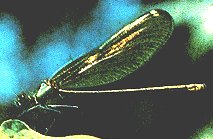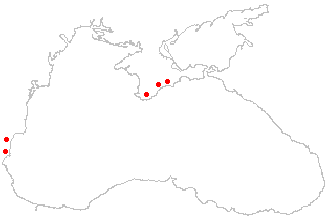 Synonyms: Libellula
splendens Harris, 1782:99; Calopteryx splendens Selys
& Hagen, 1850:138; Calopteryx splendens balcanica
Fudakowski, 1930:57-63.
Synonyms: Libellula
splendens Harris, 1782:99; Calopteryx splendens Selys
& Hagen, 1850:138; Calopteryx splendens balcanica
Fudakowski, 1930:57-63.Calopteryx splendens balcanica (Fudakowski, 1930)
 Synonyms: Libellula
splendens Harris, 1782:99; Calopteryx splendens Selys
& Hagen, 1850:138; Calopteryx splendens balcanica
Fudakowski, 1930:57-63.
Synonyms: Libellula
splendens Harris, 1782:99; Calopteryx splendens Selys
& Hagen, 1850:138; Calopteryx splendens balcanica
Fudakowski, 1930:57-63.
Common names: Engl: Banded demoiselle; Russ: Krasotka blestyashchaya balkanskaya; Turk: Yaz yusufcugu.
Order (Scientific): ODONATA.
Family (Scientific): CALOPTERYGIDAE.
Taxonomic description: Total body length 49-51 mm, length of hindwing 29-31 mm. Eyes relatively small, hemispherical, distant, situated laterally on the head. Both wing pairs similarly shaped. Pronounced sexual dimorphism in coloration. Male: body shining metallic blue-green; wings clearly bicolored - basal third hyalinous, veins blue, distal area with a broad brownish-blue band; usually, the latter leaves wingtips again colourless, but the main distinctive feature of this subspecies is the variation of hyalinous zone at tips, from 2-3 mm in breadth, to totally darkened wingtips. Female: Abdomen slender, generally olive greenish; wings from colourless to green-brownish nuancing due to the shining green veins.
 IUCN Status:
IUCN Status:
World level:
Black Sea Regional level: LR
Subregion level: VU (Bulgarian coast)
Distribution: Palearctic, polytypic species, occuring in the East as far as the Baikal lake; this subspecies inhabits the Balkan peninsula, the populations in Bulgaria (including the Black Sea coastal region) showing features transitive between the nominate C. s. splendens and C. s. balcanica.
Habitats type, Critical habitats, Limiting factors: Brooks and rivers rich in vegetation and slow water velocity, from sea level to ca. 1000 m a.s.l. in the mountains. The main limiting factors are water pollution and the elimination of zones rich in vegetation as a result of stream realignments.
Biology: Larvae rheophilous, relatively common, inhabitants of rich in vegetation localities in the rhithral and the potamal; both larvae and adults active predators. Two year life cycle. Period of emergence - V-IX. Adults relatively slow fliers.
Population trends: Although not measured, a trend of density declination is observed above all in Black Sea coastal brooks and wetlands.
Threats: Polluting and/or drying up of the habitats as a result of urbanization as well as of uncontrolled stockfarming activity both on the coastal plain and in mountainous regions.
Conservation measures taken: Some of the habitats are in the “Uzunbodzhak” and “Silkosiya” forest reserves.
Conservation measures proposed: Inclusion of Calopteryx splendens balcanica in the List of Rare and Vulnerable Species.
References:
Compiled by: K.Kumanski.